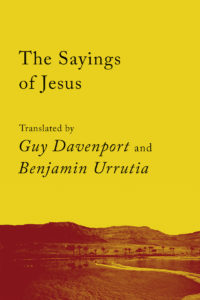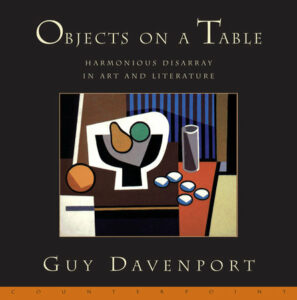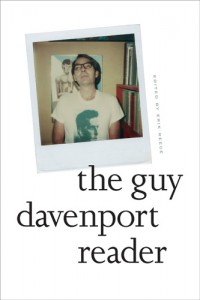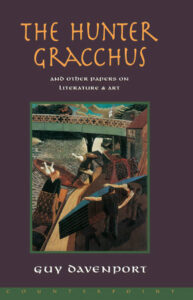Guy Davenport
Guy Davenport was a writer, illustrator, teacher, and scholar. He is best known for his modernist-style short stories, but his range of works is wide, spanning poetry, translation, and criticism. He was a professor of English for three decades, having taught at Haverford College and the University of Kentucky.
Subscribe to our newsletter for news & events from Counterpoint Press.
Books
Questioning Minds
The Letters of Guy Davenport and Hugh Kenner
"The most intellectually exhilarating work published in 2018 . . . A lasting treasure." —Michael Dirda, The Washington PostHugh Kenner (1923–2003) and Guy Davenport (1927–2005) first met in September 1953 when each gave a paper on Ezra Pound at Columbia University. They met again in the fall of 1957, and their correspondence begins with Kenner's letter of March 7, 1958. In the next forty–four years, they exchanged over one thousand letters. An extraordinary document of a literary friendship that lasted half a century, the letters represent one of the great and—with the dawn of the age of text and Twitter—one of the last major epistolary exchanges of its kind. Students and lovers of modernism will find, in the letters, matchless engagements with Eliot, Joyce, Beckett, Basil Bunting, Charles Tomlinson, R. Buckminster Fuller, Stan Brakhage, Jonathan Williams, and the American modernists William Carlos Williams, Marianne Moore, and Louis Zukofsky. The correspondence ends with Kenner's letter of August 9, 2002, lamenting how they had drifted apart.
The extensive notes and cross–referencing of archival sources in Questioning Minds are a major contribution to the study of literary modernism. The letters contained within explore how new works were conceived and developed by both writers. They record faithfully, and with candor, the urgency that each brought to his intellectual and creative pursuits. Here is a singular opportunity to follow the development of their unique fictions and essays.
The Sayings of Jesus
The Logia of Yeshua
Jesus was a street preacher who taught through story and aphorism. Antedating the Gospels, these 105 sayings were recorded by his followers during and shortly after his lifetime. Through the immediacy of direct quotation, Guy Davenport and Benjamin Urrutia’s bold translation shakes our preconceptions, reintroducing us to the West’s greatest teacher, whose powerful words ring anew.Objects on a Table
Harmonious Disarray in Art and Literature
This collection of four essays on the art of the still life begins with a look back to pictures of meals painted on the walls of Egyptian tombs--as the author points out, the soul could eat. Davenport’s meditations on the still life dip into the full history of this art form, touching on neolithic cave paintings, the Dutch masters, Cezanne, Van Gogh, even photography and the collage.The Guy Davenport Reader
"The difference between the Parthenon and the World Trade Center, between a French wine glass and a German beer mug, between Bach and John Philip Sousa, between Sophocles and Shakespeare, between a bicycle and a horse, though explicable by historical moment, necessity, and destiny, is before all else a difference of imagination.The imagination is like the drunk man who has lost his watch, and must get drunk again to find it. It is as intimate as speech and custom, and to trace its ways we need to re–educate our eyes."—Guy Davenport
Modernism spawned the greatest explosion of art, architecture, literature, painting, music, and dance of any era since the Renaissance. In its long unfolding, from Yeats, Pound and Eliot to Picasso and Matisse, from Diaghilev and Balanchine to Cunningham and Stravinsky and Cage, the work of Modernism has provided the cultural vocabulary of our time.
One of the last pure Modernists, Guy Davenport was perhaps the finest stylist and most protean craftsman of his generation. Publishing more than two dozen books of fiction, essays, poetry and translations over a career of more than forty years, he was awarded a MacArthur Fellowship in 1990. In poetry and prose, Davenport drew upon the most archaic and the most modern of influences to create what he called "assemblages"—lush experiments that often defy classification. Woven throughout is a radical and coherent philosophy of desire, design and human happiness. But never before has Davenport's fiction, nonfiction, poetry and translations been collected together in one compendium. Eight years after his death, The Guy Davenport Reader offers the first true introduction to the far–ranging work of this neglected genius.
The Death of Picasso
New and Selected Writing
When Guy Davenport looks at the world, the world changes; sometimes just a little and sometimes a lot. And no reader is the same after reading his or her first Davenport essay or story. He is a writer perfectly described by the term "singular" and in praising his work, from fiction to poetry, from translations to essays, critics all over the world have noted his unique manner, his remarkable erudition and his startling humor. He is the finely realized perfection of high modernism blended with an American sensibility as old as Emerson's."The way I write about texts and works of art," Davenport has written, "has been shaped by forty years of explaining them to students in a classroom. I am not writing for scholars or fellow critics, but for people who like to read, to look at pictures, and to know things."
For The Death of Picasso, Davenport has gathered twenty–six essays and stories from throughout his career, more than one–third of which have never before appeared in book form. The result is an exciting and invigorating selection, a testament to one of the prose masters at work today.
The Hunter Gracchus
And Other Papers on Literature and Art
These essays cover a range of topics, including art and architecture, religion, and literature in a collage of ideas, commentary, and criticism from snake handling to Wallace Stevens.
Catapult | Counterpoint | Soft Skull
20 Jay Street #704
Brooklyn, NY 11201
646.926.0805 | contact@catapult.co










